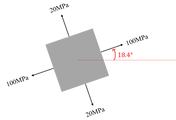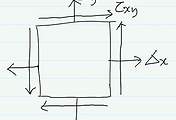지난 글에서 유도한 응력의 변환방정식은 아래와 같습니다.
σx′=σx+σy2+σx−σy2cos2θ+τxysin2θ
τx′y′=−σx−σy2sin2θ+τxycos2θ
최대전단응력공식을 유도할때는 두번째 식이 사용됩니다. 변수는 θ 입니다. θ로 미분한 함수가 0이 되는 θ 에서 극값이 발생합니다.
두번째 식을 θ 로 미분하면 아래와 같습니다.
dσx′dθ=−(σx−σy)cos2θ−2τxysin2θ=0
아래와 같이 변형합니다.
sin2θcos2θ=−(σx−σy)2τxy
좌변은 탄젠트입니다.
tan2θ=−(σx−σy)2τxy
위 등식을 만족하는 θ 를 구할 필요는 없습니다. 아래그림의 θ1과 θ2가 위 등식이 만족한다는 것을 알면 됩니다. (어떤 교제는 다른 방식으로 각도를 잡기도 합니다. 결과는 같습니다.)

또한 θ1과 θ2는 90도 차이임을 알 수 있습니다.
θ=θ1일 때 전단응력의 변환방정식은 아래와 같이 변형됩니다. 위 그림에서 sin2θ1과 cos2θ1을 구하여 넣어주었습니다.
τmax=−σx−σy2σx−σy2√(σx−σy2)2+τ2xy+τxy−τxy√(σx−σy2)2+τ2xy
아래와 같이 계산해줍니다.
τmax=−(σx−σy2)2+τ2xy√(σx−σy2)2+τ2xy
아래와 같이 변형합니다.
τmax=−√(σx−σy2)2+τ2xy
θ=θ2일 때도 같은 방법으로 구하면 아래와 같습니다.
τmax=√(σx−σy2)2+τ2xy
부호규약을 적용하여 최대전단응력만 나타내면 아래와 같습니다.

최대전단응력 상태에서 수직응력은 어떤 값을 가질까요? θ1과 θ2에서 수직응력을 구하면 아래와 같습니다. 수직응력변형공식에 위에서 구한 사인과 코사인 값을 대입해서 구하면 됩니다.
σx′=σx+σy2
σy′=σx+σy2
위 응력은 x방향과 y방향의 평균응력입니다. σavg라고 부릅니다. 따라서 최대전단응력상태에서 요소는 아래와 같이 나타낼 수 있습니다.

이번에는 주응력과의 관계를 알아봅시다. 주응력이 발생하는 각도는 아래와 같습니다.
tan2θ=τxy(σx−σy)2
최대 전단응력이 발생하는 각도는 아래와 같습니다.
tan2θ=τxy(σx−σy)2
탄젠트값의 부호가 다르다는 것은 90도 차이임을 의미합니다. 2θ가 90도 차이이므로 θ는 45도 차이입니다.
아래는 요약입니다.
1. 최대전단응력은 전단응력 변환공식을 미분한 값이 0이 될 때 발생하며, 발생 각도와 최대전단응력은 아래와 같다.
tan2θ=−(σx−σy)2τxy
τmax=−√(σx−σy2)2+τ2xy (at θ1)
τmax=√(σx−σy2)2+τ2xy (at θ2)
2. θ1과 θ2는 90도 차이이고, 최대전단응력상태에서 주응력은 σavg 이므로 아래와 같이 나타낼 수 있다.

'재료역학 > 평면응력과 응력 변환' 카테고리의 다른 글
| [재료역학] 평면응력 (6) 모어원 유도 (0) | 2022.06.15 |
|---|---|
| [재료역학] 평면응력 (5) 최대전단응력 예제 1 (0) | 2022.06.15 |
| [재료역학] 평면응력 (4) 주응력 예제 1 (0) | 2022.06.14 |
| [재료역학] 평면응력 (2) 주응력공식 유도 (0) | 2022.06.09 |
| [재료역학] 평면응력 (1) 응력의 변환방정식 유도 (0) | 2022.06.07 |




댓글